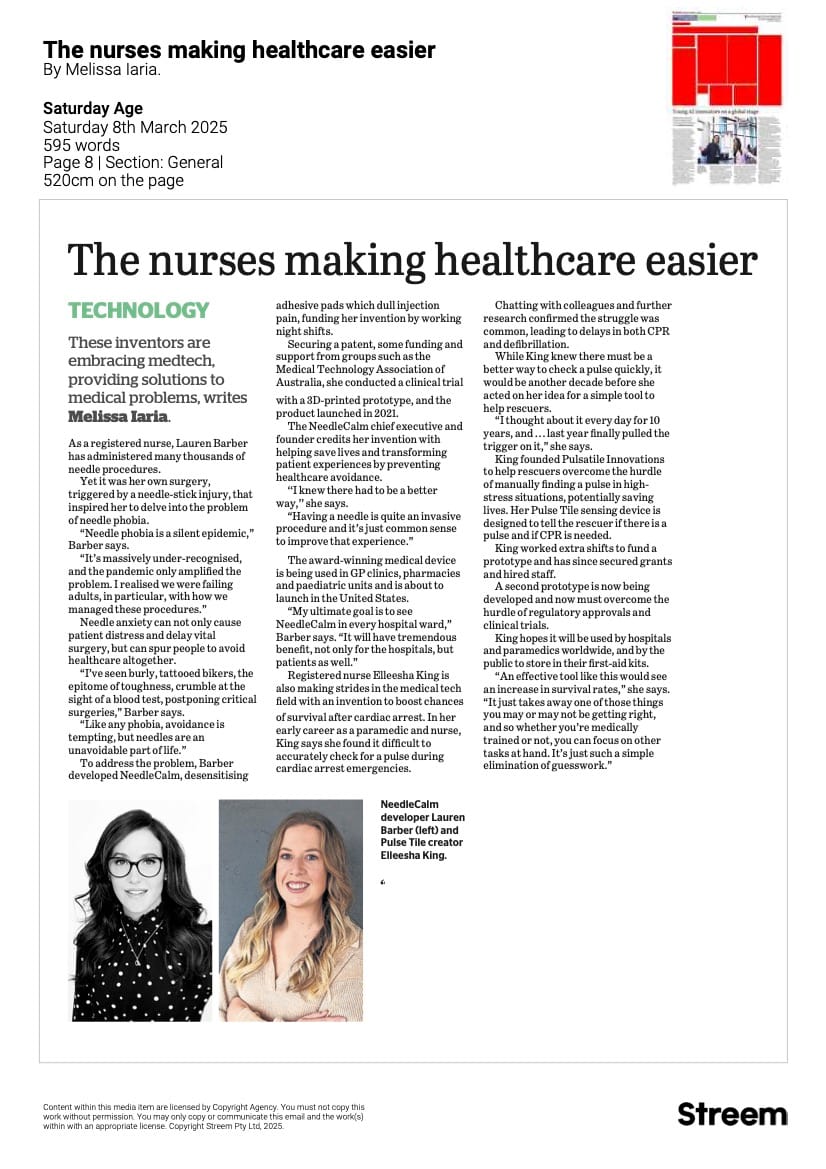Published in The Age, 8 March 2025
These inventors are embracing medtech, providing solutions to medical problems, writes Melissa Iaria.
As a registered nurse, Lauren Barber has administered many thousands of needle procedures. Yet it was her own surgery, triggered by a needle-stick injury, that inspired her to delve into the problem of needle phobia.
“Needle phobia is a silent epidemic,” Barber says. “It’s massively under-recognised, and the pandemic only amplified the problem. I realised we were failing adults, in particular, with how we managed these procedures.”
Needle anxiety can not only cause patient distress and delay vital surgery, but can spur people to avoid healthcare altogether. “I’ve seen burly, tattooed bikers, the epitome of toughness, crumble at the sight of a blood test, postponing critical surgeries,” Barber says.
“Like any phobia, avoidance is tempting, but needles are an unavoidable part of life.”
To address the problem, Barber developed NeedleCalm, desensitising adhesive pads which dull injection pain, funding her invention by working night shifts. Securing a patent, some funding and support from groups such as the Medical Technology Association of Australia, she conducted a clinical trial with a 3D-printed prototype, and the product launched in 2021.
The NeedleCalm chief executive and founder credits her invention with helping save lives and transforming patient experiences by preventing healthcare avoidance.
‘‘I knew there had to be a better way,’’ she says. “Having a needle is quite an invasive procedure and it’s just common sense to improve that experience.”
The award-winning medical device is being used in GP clinics, pharmacies and paediatric units and is about to launch in the United States.
“My ultimate goal is to see NeedleCalm in every hospital ward,” Barber says. “It will have tremendous benefit, not only for the hospitals, but patients as well.”
Registered nurse Elleesha King is also making strides in the medical tech field with an invention to boost chances of survival after cardiac arrest. In her early career as a paramedic and nurse, King says she found it difficult to accurately check for a pulse during cardiac arrest emergencies.
“Chatting with colleagues and further research confirmed the struggle was common, leading to delays in both CPR and defibrillation. While King knew there must be a better way to check a pulse quickly, it would be another decade before she acted on her idea for a simple tool to help rescuers.
“I thought about it every day for 10 years, and . . . last year finally pulled the trigger on it,” she says. King founded Pulsatile Innovations to help rescuers overcome the hurdle of manually finding a pulse in high-stress situations, potentially saving lives.
Her Pulse Tile sensing device is designed to tell the rescuer if there is a pulse and if CPR is needed. King worked extra shifts to fund a prototype and has since secured grants and hired staff.
A second prototype is now being developed and now must overcome the hurdle of regulatory approvals and clinical trials. King hopes it will be used by hospitals and paramedics worldwide, and by the public to store in their first-aid kits. “An effective tool like this would see an increase in survival rates,” she says. “It just takes away one of those things you may or may not be getting right, and so whether you’re medically trained or not, you can focus on other tasks at hand. It’s just such a simple elimination of guesswork.”

